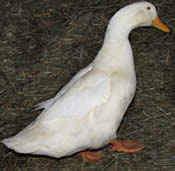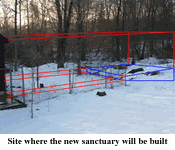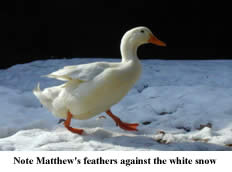|
In This Issue...
 |
Liv
and her new home |
 |
Building Day Approaches |
 |
Joseph Walks! |
 |
Fencing Hazards |
 |
"Yellow" White Ducks?! |
 |
Importance of a Vet |
 |
Detecting Illness Early |
 |
Egg Binding |
 |
Wanted: The Perfect Net |
 |
Ducky foods to avoid |
 |
Predator Barriers |
 |
Thank you Volunteers! |
 |
Reader Poll #4
|
|
|
|
Egg Binding |
|
Egg binding
often occurs when a hen cannot pass her egg through her
oviduct at a normal rate. This is often the result of soft
shelled or misshapen egg that cannot easily be passed
because of its shape or texture. Egg binding is often the
result of a nutritional problem or genetic predisposition
Some signs
that your duck is having trouble passing her egg are:
- Open bill panting
-
Pumping
tail feathers
-
Reluctance
to walk
-
Walking
with a stiff waddle
-
Standing
awkwardly upright
-
Waddling
very low to the ground
As soon as you
notice your duck having trouble passing her egg, seek out
vet care.
If she is not
in too much distress, they may suggest that you give her a
little more time and place her in a warm bath in a warm and
quiet room. We have never had success with this tactic at
the sanctuary and find this only wastes precious time. This
can also make the difference between your vet's practice
being open or closed. Don't wait for it to close!
Egg binding
can be FATAL!
Vets will
perform an exam to see if they can feel the egg. Sometimes
they will also do an x-ray to get an exact picture of what
is going on inside. They will often lubricate her oviduct to
help the egg along and give her a shot to increase her
contractions to further assist egg movement in the oviduct.
Sometimes
surgery is performed to remove an impacted egg. Vet's will
be very careful to remove the egg without breaking it. If
they leave any pieces of egg shell behind it can mean death
for your hen.
Once your hen
is home, it will be vital for you to re-check her diet and
make sure she is on the proper ration of breeder/layer mix
AND has 24/7 access to an additional calcium source.
Laying hens
should be on a minimum of 1/4 breeder/laying formula. We
have had the best results utilizing Mazuri Waterfowl
Breeder. As long as your hen's eggs are normal (smooth in
texture, symmetrical, of appropriate size and normal
thickness and appearance), you can stick with this ratio.
Examine your
hen's daily egg, if you notice any abnormal oddities,
increase her breeder ratio to 1/3. You can further increase
to 1/2 and even higher, as needed. When her eggs appear
normal again, stop increasing the ratio.
Too much
breeder/laying formula can encourage an overactive laying
cycle. It is best to utilize the lowest possible ratio of
breeder formula necessary to provide positive results. This
way you are balancing mother nature and not pushing her.
Wait for your
hen's eggs to appear normal again and then SLOWLY lower the
percentage of breeder again. Monitor her progress closely
and find the equilibrium where you are utilizing the
healthiest ratio of breeder to produce the best quality egg.
Wanted: A Perfect Net
We have been emailing zoos,
aviaries, and net producing companies throughout the U.S. in an
attempt to find aviary nets that can tolerate wind and the weight of
snow as well as being able to withstand a predatory attempt at
biting through.
If anyone
knows of a source of an aviary net that can live up to these
high standards, please contact us.
Ducky Foods to Avoid
Some
foods that you may think are good for your ducks and geese may
actually be bad for them. Spinach is one of a few seemingly healthy
treats that your ducks may love, but that should actually be
avoided. Beneficial calcium that your hens need for their egg laying
binds with the oxalic acid in spinach and is then removed from their
system. Some other snacks that are high in oxalate and should be
avoided are:
Beets, celery, collard
greens, dandelion greens, eggplant,
escarole, green beans, kale, leeks, okra,
parsley, parsnips, peppers, pokeweed, popcorn, sweet potatoes, pumpkin,
rhubarb, rutabagas, sorrel, squash, swiss chard, tomato sauce, turnip
greens,
watercress and yams.
Predator Barriers
While
researching our best options for building our new sanctuary, we
discovered a brilliant anti-predator trick that we wanted to share
with our waterfowl friends.
Dig a trench around
your enclosure 24" outwards and 6" deep. Attach a piece of wire mesh
(rabbit fence that rodents can't fit through or chew through) to the
bottom of your enclosure’s fence and bend it downwards and outwards
into the trench. Cover the wire mesh with dirt and plant grass. Any
predator that digs at the fence line of your enclosure will hit the
mesh and they aren't smart enough to back up 24" and try again. This
will prevent rodents and other predators from digging their way into
your enclosure.
Thank You Volunteers!
Majestic sincerely thanks the
Managers of Agway Plainfield, CT and Agway Norwich, CT for
displaying our educational brochures and flyers in their stores.
We would also like to
extend a special thank you to Elaine for arranging for our
information to be displayed at her local Agway in Kittery
ME.
An equally special thanks to Glynis
and Eric for arranging
for our information to be displayed at local stores in
Lexington KY.
If you are a manager of a
business that sells ducklings and would like to display our
information in your local store, please contact us! |
|
|
|
Reader
Poll #4 |
Question: Do you
have a waterfowl or avian vet you can take your duck or
goose to in the event of a medical emergency?
Results of Reader
Poll#3:
Do you
think ducks and geese make good house pets?
|
Yes
.....................44% |
|
No
......................34% |
|
Unsure
................22% |
| |
 |
|
|
Contact
Us |
Majestic Waterfowl
Sanctuary
17 Barker Road
Lebanon, CT 06249
directorATmajesticwaterfowl.org
|
|
Our Newsletter |
|
The Majestic Monthly is published 12 times per year. Back
issues can be obtained online from our
Newsletter Archives. |
 |
 |
|
Liv Walks
Into Her New Home
 March
19th was more than a warm and sunny Saturday, it was time to make
the call to Liv’s new family and share the good news. Liv has been
in our care since her rescue from Spaulding Pond last November. She
came to us with a very severe limp that required a long period of
rest, an x-ray, and a round of hydrotherapy in our tub 2-3 times a
week. Her limp was most likely the result of a torn ligament or
severe sprain. March
19th was more than a warm and sunny Saturday, it was time to make
the call to Liv’s new family and share the good news. Liv has been
in our care since her rescue from Spaulding Pond last November. She
came to us with a very severe limp that required a long period of
rest, an x-ray, and a round of hydrotherapy in our tub 2-3 times a
week. Her limp was most likely the result of a torn ligament or
severe sprain.
Liv was saddened when
her mate Viggo went ahead of her to their new home. She truly missed
him, but his moving on before her opened up room for another rescue
to come in.
A sign of Liv’s
continued improvement became evident by the bucket of water in her
enclosure that she emptied out twice a day while splashing it on
herself to bathe. Little spurts of energetic strolling turned into
the ability to walk and stand as often as she chose. We made the
decision that she was ready to go, and we called her new family to
let them know. Within a couple hours after calling, her new family
arrived and Liv was in a carrier and on her way to her new home to
be reunited with Viggo.
We look forward to
hearing more about the lovely couple in the months to come!
Building Day Approaches
As
building day approaches, we are working on getting the word out that
we are looking for equipment to excavate the pond in our new
sanctuary. We have had a number of volunteers step forward to help
out with the manual part of landscaping and building and we thank
all of them for their participation. If you are interested in
helping with the building/landscaping of the new sanctuary please
contact us at:
directorATmajesticwaterfowl.org.
 The
DEP came in for a site inspection in March and determined that our
plans to build the 35’ x 75’ sanctuary with enclosed stream-fed pond
will also benefit our wildlife. They described the land we are
readying to work as being “very disturbed.” The plow work done with
bulldozers when the lot was originally developed over fifteen years
ago was rather careless. They left very large mounds of pushed dirt
piled around the streambed causing land barriers that prevent easy
wildlife access. Our work will remove these land obstacles and
provide a more hospitable area for our wildlife while providing a
sanctuary for domestic waterfowl. The
DEP came in for a site inspection in March and determined that our
plans to build the 35’ x 75’ sanctuary with enclosed stream-fed pond
will also benefit our wildlife. They described the land we are
readying to work as being “very disturbed.” The plow work done with
bulldozers when the lot was originally developed over fifteen years
ago was rather careless. They left very large mounds of pushed dirt
piled around the streambed causing land barriers that prevent easy
wildlife access. Our work will remove these land obstacles and
provide a more hospitable area for our wildlife while providing a
sanctuary for domestic waterfowl.
Joseph Walks!
Joseph
came into our care only months ago and already he has molted and
grown a batch of beautiful new feathers. He is once again waterproof
and he can float and swim. His hydrotherapy proved very successful
and he strengthened himself up enough to be able to stand up for
just as long as he likes.
As if this wasn’t
wonderful enough, he has transformed from a meek and shy animal into
an extremely friendly, loving and appreciative guest. Joseph loves
people and loves giving and receiving hugs.
When the sun finally
came out and the skies turned blue, we brought Joseph outside for
some nice, fresh air. He amazed us by following behind us and taking
a ten foot stroll before settling down to rest. We emailed the
Huffman’s and let them know that their new duck is feeling much
better and can join them at any time. Glynis and Eric will be flying
up from Kentucky in May to drive Joseph home to live happily ever
after with their hens Qwaka and Fiona.

The Hazards of Chain Link
Fencing
Be
very cautious when using chain link fencing around your waterfowl.
This is especially true when you have ducks or geese on opposing
sides of the same chain link fence who may be tempted to poke their
heads through for visits or to resolve pecking order disputes.
Chain link
fencing can be made safe for ducks and geese by tie-wrapping deer
fencing/deer barrier over the chain link panels to ensure that
feathery heads and necks can’t fit through the fencing and get
trapped. Ducks and geese can actually poke their heads through one
square of the fencing, panic and bring their head back to their own
side of the fence through the incorrect square. The result of this
action is a sort of weaving in and out through the fencing and it
can be deadly.

"Yellow" White Ducks?!
The
number one comment we hear about our Young Matthew when we are at
Petco locations is, “Why is he yellow?”
When Pekin ducks are
healthy and well-nourished, their feathers are creamy in color. This
color really stands out in the winter when the ducks can be seen
against the snow. If your Pekin is a nice, creamy yellow, it is a
sign that life is good!

The Importance of a
Waterfowl Vet
Many
people will take their dogs and cats to vets, but far less feel that
their duck or goose is worthy of vet attention. Broken limbs and
injuries resulting from predatory attacks are often left
unaddressed. Ducks and geese experience pain and trauma the same as
cats and dogs and the same as people. They should not be left to
recover on their own or have to endure homemade remedies in lieu of
real veterinary care.
Broken bones should
not be reset at home using makeshift splints in order to safe time
or money. Pain medication, anti-inflammatory and antibiotics are
often required.
Infections often
result from predatory attacks in bite wounds and need flushing and
antibiotics. Further, the animals need special attention given to
any pain they are experiencing.
In addition, this is
a time when your pet duck or goose will need special attention and
re-assurances from you. Special TLC to nurture them back into good
health is needed by waterfowl just as it is needed by any other
animal.
It is not always easy
finding an avian vet who will handle ducks and geese in addition to
their normal parrot patients, so it is wise to locate a vet early
on--preferably before you acquire ducks or geese. It is never a wise
idea to try to track down a vet after your pet becomes ill or
experiences trauma, especially when it comes to ducks and geese--who
are not treated by many vet practices.
If you
need to locate an avian/waterfowl veterinarian near you you can
search avian vet directories and call individual practices to ask
which ones handle ducks and geese:
AAV Vet Lookup
We are
always building our own Waterfowl Vet Finder. You can look here
first for known waterfowl vets. If you find a practice not on our
list, please let us know:
Majestic
Waterfowl Vet Finder
Detecting Illnesses Early
& Seeking Vet Care
Ducks and
geese are infamous for hiding their illnesses. This is one of their
defense mechanisms against predators, that are looking for a weak
member of the flock to target. This means that your pet duck or
goose will inadvertently be hiding its ailments from you too.
It is vital to watch
your birds closely, so that you can detect slight changes early on
and seek vet assistance before the masked ailment escalates. Often,
by the time you see a noticeably sick bird, advanced stages of
illness are already reached.
Some of the things you want to
watch out for are:
 |
Respiratory differences;
over-exertion while breathing, tail pumping, raspy sounds |
 |
Listlessness |
 |
Ruffled or fluffed-up feathers |
 |
Disinterest in preening,
bathing, cleaning |
 |
Dietary changes; eating more
or less |
 |
Any kind of discharge from
eyes, bill or vent |
 |
Limping |
 |
Wings being held in abnormal
positions |
 |
Lack of energy |
 |
Vomiting (yes, ducks and geese
do throw up) |
 |
Bleeding |
 |
Diarrhea |
 |
Lack of droppings |
 |
Change's in waking and
sleeping habits |
 |
An instinctual feeling that
your duck or goose is just not behaving right. This is
commonly the first symptom. It can include lack of interest
in activities that they normally would not avoid, delays in
coming over to see you. Sudden and abnormal disinterest. It
is a vague symptom, but usually the first symptom that their
is a health issue. |
If you see any of
these symptoms you will be wise to see a vet as soon as possible.
Avoid trying to treat your duck or goose utilizing over-the-counter
or holistic remedies. Often a round of antibiotics (Baytril) will be
prescribed by a vet to address any hidden infections.
|